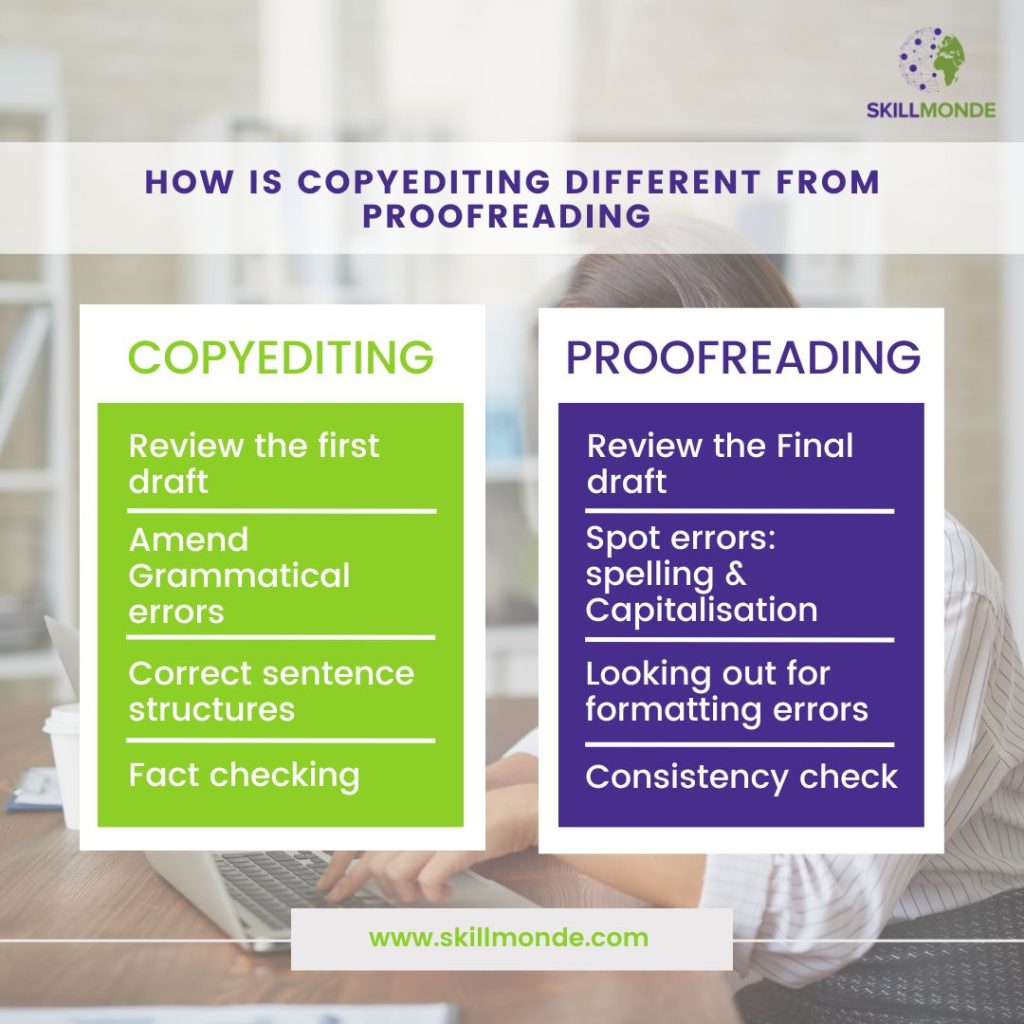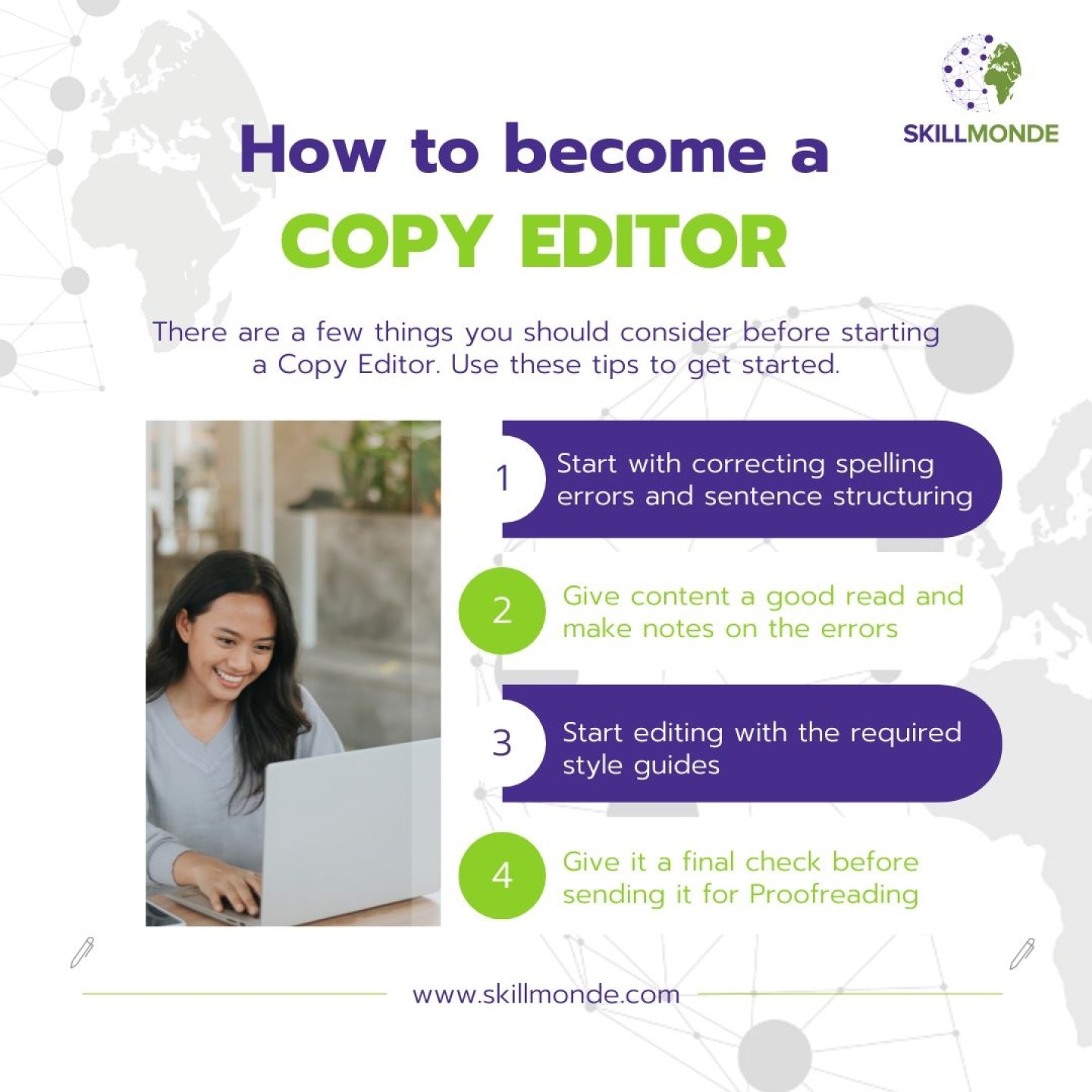Copy editing is at most times considered a work of copy and pasting and many times thought of as proofreading. There is a definite workflow for every work to be completely done. Copy editing is one such step in the editorial workflow. It is the task of finding mistakes in grammar, sentences, spelling, and punctuation and correcting them in an article. It streamlines the article by simplifying the language without swapping the intent and idea of the writer, for easy understanding of the readers.
To become a copy editor, command of the language is a prerequisite skill. This job requires fact-checking too when the work of the writer is based on facts and correcting them where necessary. Copy editors are well versed with style guides of different publishers, and therefore ensure that the writing does not legally violate the ethical standards of publishers.
Copy editing revolves around “the Five C’s”, known as the five fundamental traits of copy editing. They are Clear, Correct, Concise, Comprehensible, and Consistent. The prime focus is to make the article convey exactly what the writer is intending to. It is important to make use of appropriate words for clear understanding. The next step involves making corrections in grammar, spelling, punctuation, and other errors where required.
It is best to avoid repetition and superfluity and make the writing crisp and concise. A good copy editor will always see the work from the readers’ side and make the content readable by structuring the paragraphs and sentences by choosing alternative phrases and words. Last is maintaining consistency of the content. A good copy editor maintains the style guide of the publisher throughout the article.
How to become a Copy Editor
Copy editing calls for creativity as copy editors need to sense both the tone and errors in the script. Their task is to make the content engaging and lessen the use of jargon to attract mass readers. The service of copy editing is often done before proofreading, however, the services may not be the same everywhere.
You can become a copy editor by following these steps:
Start with basic task:
If you are new in the industry then it is best to start with the basic role of correcting spelling errors and sentence structuring. After gaining a few years of experience in the field is when you can think of taking up a bigger role that comes with work expansion and exposure.
A thorough first reading:
Before starting to edit, it is best to first give the content a good read as a reader and not as an editor. This will make you get to the writer, feel what the tone is, and understand what the writer wants to convey.
Second reading:
Give a second reading to the content and this time see where the loopholes are. Copy editing requires patience, understanding, thorough reading, and excellent knowledge of the language. While reading, you have to check whether the sentences are presented orderly, the paragraphs are structured correctly, and whether facts are used in the article so that you can cross-check them. Highlight and make notes of them so that you don’t waste your time when you start editing them.
Start editing:
After making notes of making corrections where necessary, you can go back to the beginning again to start editing. You can also suggest alternate word choices in the sentences and paragraphs.
Well-verse with Style guide:
It is best to comply with the required style guides while making edits, whether that be the Chicago Manual of Style, Associated Press Stylebook, or any other. It depends on the publishing house you will be working for that will instruct you which guide style to follow.
Final Reading:
It is important that you check your work and give it a final read after editing and before sending it for proofreading. This will ensure producing text which is free from error.
Copy editors become a writer’s friend and best critics as they go through their writings, find even the minute errors, correct them and make the article readable. In this rat race where it gets decided by a single touch on the screen, your article may find its place at the top of the search list or nowhere to be found by choosing a professional copy editor for your work.
How is Copy Editing different from Proofreading?

Copy editing is a process that comes before the stage of proofreading in editorial work. After copy editing has been done, proofreading is carried out as the last step for making corrections before giving it to print to reach the readers. This is the reason why copy editing and proofreading overlap each other and sometimes are used interchangeably. However, there is a distinct difference between these two which we shall learn more about here.
Proofreaders get a printed copy of the edited version of the script to check for any absence of pages and quality issues. Since it is a well-edited file from the copy editor; proofreaders usually don’t find errors generally and give their approval for the copy printed in bulk. Proofreading does not involve making corrections but highlighting where the mistakes are and sometimes, returning the copy for change where it is felt that requires improvement.
Proofreading generally lists the following errors in cases where the copy editors have missed out on –
1. Indexing
2. Text alignment
3. Page numbering
4. Paragraph structuring
5. Check word spacing
The responsibilities of a proofreader are not limited to these five and its work is more challenging for proofreading calls for a thorough reading of the script again to find even the smallest error in the text. It is different from copy editing.
FAQs:
1. What are the basic guidelines of copy editing?
Answer: List of rules for copy editing is:
- No space for bad grammars
- Use of apostrophe in proper places
- Check whether the sentence structure is correct
- Discard sentences that makes no sense or meaning
- Avoid using colloquial words like totally
- Avoid rhetorical questions
2. What does a copy editor do?
Answer: The role of a copy editor is to make sure that the piece of writing is correct, clear and accurate. Few of the basic work also involves
- Check facts
- Ensuring that punctuation, grammar and correction are correct
- Proofread and check consistency
- Trim the unnecessary words from the piece of writing
- Eliminate use of jargons and complex words and instead simplify the language for easy understanding
- Check the calculations if there are any and ensure that all the charts and maps are correct
3. Why is Copy editing required?
Answer: Copy editing is important because this process makes the piece of writing 100% error-free of punctuations, spelling, sentence structure and syntax, and get the facts right.
4. Who hires a Copy editor?
Answer: Every organization hires a copy editor. Writing is essential in every firm and organisation for advertisement, branding, promotion and others. And when writing is in the scene then copy editing must be involved. So rest assured, copy editors are high in demand in the market.
5. What are the common mistakes that most copy editors commit?
Answer:
- Overuse of pronouns
- Overlook improper hyphenation and inconsistency of the writing
- Structural errors like line editing, story editing and content development
- Skip cross referring the facts
- Rely on apps like spellcheck for your work
6. What should be expected from a Copy editor?
Answer:
- When you are hiring a copy editor, the following things should be ready.
- What is the type of writing? Whether it is blog, book, academic journal or official document
- Does the writing adhere to any reference citation guide? Like, APA, Chicago or any other.
- Convey the word limit of the writing.
The copy editor would carefully go through the writing line by line to spot the mistakes and make edits. Expect the document with comments and questions from the copy editors. You can either accept the changes or speak with the editor to beautify the language and your work.
7. How much do Copy editors charge for copy editing?
Answer: For beginners, copy editors may charge 40 paisa per word for editing. And the professionals with experience charge between Re.1 and Rs.3 per word for editing.
8. What are the five C’s in copy editing?
Answer: The five C’s that every copy editor follows is clear, correct, concise, comprehensible and consistent in a piece of writing.
9. How much time do copy editors take for copy editing?
Answer: Basic copy editing may take 5 to 10 pages in an hour while heavy copy editing takes 2 to 5 pages per hour. Typically, copy editors work 40 hours per week.
10. How can Copy editors apply for a copy editing job?
Answer: There is no specific academic qualification required to become a copy editor. Excellent command over the language is essential.
